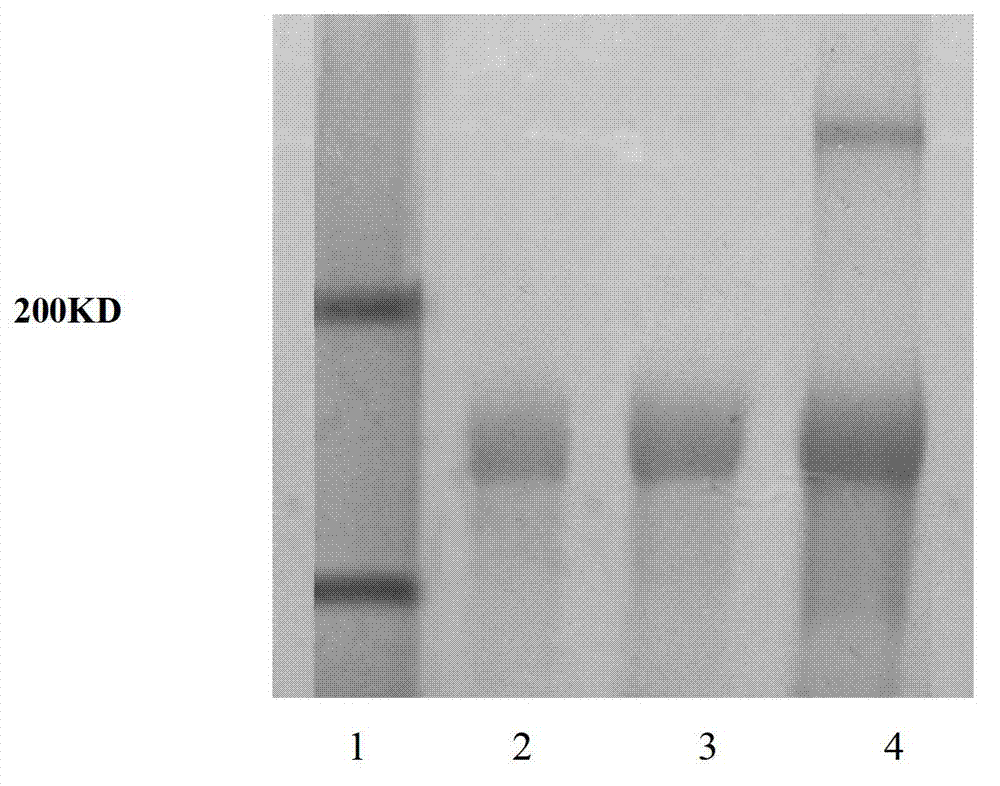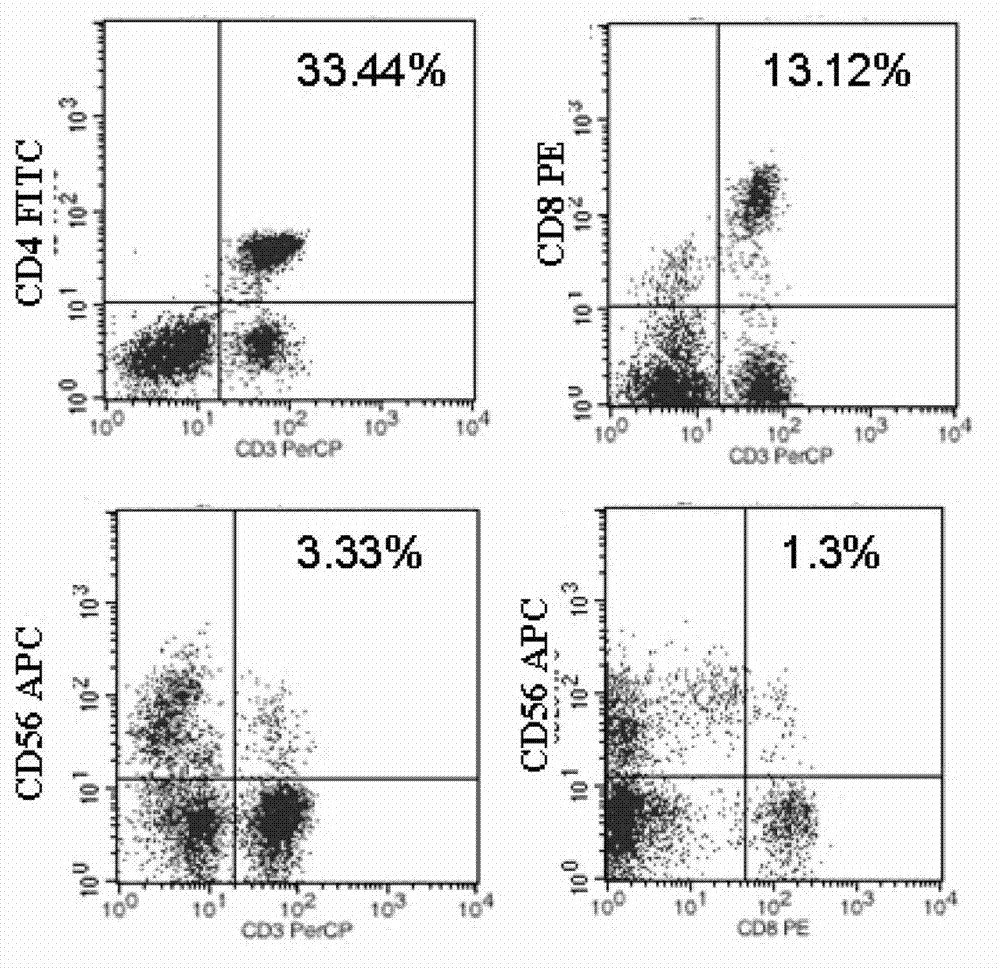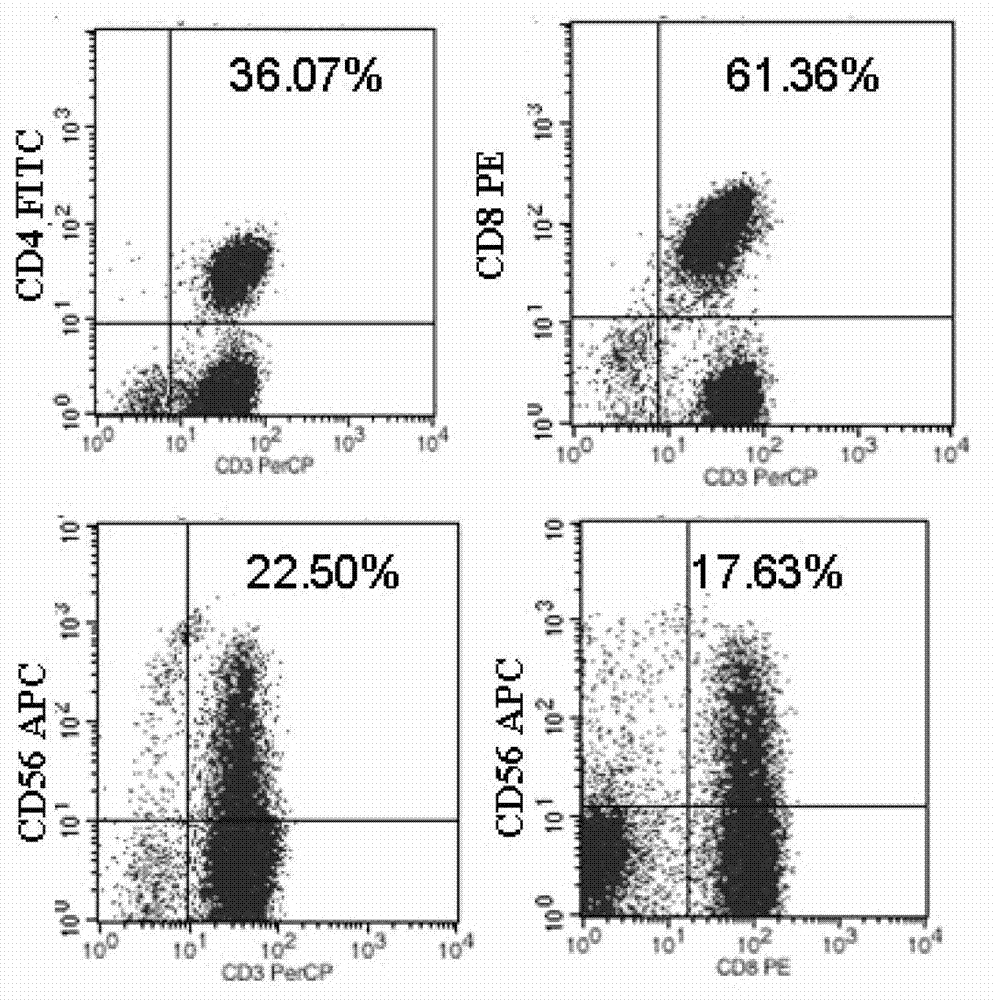CD3 resistance/CD133 resistance bi-specific antibody and CIK (cytokine-induced killer) cells loaded by CD3 resistance/CD133 resistance bi-specific antibody
A bispecific antibody and cell technology, applied in the direction of blood/immune system cells, anti-receptor/cell surface antigen/cell surface determinant immunoglobulin, anti-animal/human immunoglobulin, etc., can solve the problem of CIK cells Lack of specific targeted killing effect and limited therapeutic effect
- Summary
- Abstract
- Description
- Claims
- Application Information
AI Technical Summary
Problems solved by technology
Method used
Image
Examples
Embodiment 1
[0056] Example 1: Preparation of bispecific antibody
[0057] 1. Take the mouse anti-human CD3 monoclonal antibody OKT3 antibody (1 mg) and dissolve it in 500 μl of the cross-linking agent Traut's reagent (2-iminothiolane HCl; Pierce, Rockford, IL) at a 5-fold molar concentration, and act for 1 hour at room temperature; use PD- 10 column (Pharmacia, Uppsala, Sweden) was filtered to remove uncrosslinked monoclonal antibody,
[0058] 2. Take the mouse anti-human CD133 / 1 monoclonal antibody (1 mg) and dissolve it in 500 μl of the cross-linking agent Sulfo-SMCC (sulfosuccinimidyl4-(N-maleimidomethyl)cyclohexane-1-carboxylate) at a 4-fold molar concentration, and act for 1 hour at room temperature , filtered with a PD-10 column (Pharmacia, Uppsala, Sweden) to remove uncrosslinked monoclonal antibodies;
[0059] 3. After mixing the cross-linked OKT3 and the mouse anti-human CD133 / 1 monoclonal antibody overnight at 4°C, an anti-CD3 / anti-CD133 bispecific antibody was prepared.
[00...
Embodiment 2
[0062] Example 2: Equipping CIK cells with anti-CD3 / anti-CD133 bispecific antibody
[0063] 1. Culture of CIK cells
[0064] Take 10ml of peripheral venous blood from healthy volunteers, anticoagulate with heparin, dilute with normal saline 1:1, add to the upper layer of lymphocyte separation medium, collect mononuclear cells (PBMC) by centrifugation, and use RPMI1640 culture medium containing 5% fetal bovine serum Adjust the cell density to 2 x 10 5 IFN-γ was added at a final concentration of 1,000 units / mL, placed in a 5% CO2 incubator at 37°C for 24 hours, and rhIL-1α was added at a final concentration of 1000 U / ml, and the final concentration of mouse anti-human CD3 McAb was 50ng / ml, the final concentration of rhIL-2 was 1000U / ml, add rhIL-2 every 2 days, on the 14th day of culture, check the CD3, CD4, CD8 and CD56 phenotype of cultured cells by flow cytometry, and harvest CIK cells.
[0065] 2. Detection of CIK cell phenotype
[0066] Adjust the concentration of CIK ce...
Embodiment 3
[0072] Example 3: Detecting the Cytotoxicity of CIK Cells Equipped with Bispecific Antibodies to SW1990
[0073] CIK cells were used as effector cells, and the human pancreatic cancer cell line SW1990 was used as target cells to detect the killing effect of CIK cells equipped with anti-CD3 / anti-CD133 bispecific antibodies.
[0074] Take 10 samples of normal people and 10 samples of tumor patients' peripheral venous blood to prepare CIK cells, and load each case of CIK cells with anti-CD3 / anti-CD133 bispecific antibody, and compare and detect CIK cells and those loaded with anti-CD3 / anti-CD133 bispecific antibody, respectively. The killing experiment of SW1990 cells by CIK cells with specific antibodies.
[0075] The experimental procedure is as follows: take tumor cells in the logarithmic growth phase, spread 5000 cells / well on a 96-well cell culture plate, and add CIK cells and CIK cells equipped with anti-CD3 / anti-CD133 bispecific antibody prepared in Example 2 respectively ...
PUM
 Login to View More
Login to View More Abstract
Description
Claims
Application Information
 Login to View More
Login to View More - R&D Engineer
- R&D Manager
- IP Professional
- Industry Leading Data Capabilities
- Powerful AI technology
- Patent DNA Extraction
Browse by: Latest US Patents, China's latest patents, Technical Efficacy Thesaurus, Application Domain, Technology Topic, Popular Technical Reports.
© 2024 PatSnap. All rights reserved.Legal|Privacy policy|Modern Slavery Act Transparency Statement|Sitemap|About US| Contact US: help@patsnap.com










